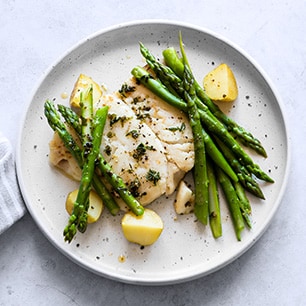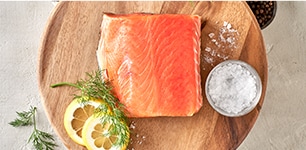Updated June 1, 2024
You may have heard that it’s wise to eat two servings of seafood per week—and that omega-3 fatty acids offer certain health benefits.1 Let’s connect the dots to learn how seafood, especially salmon and other fatty fish that are high in omega-3s, can benefit brain health from birth to adulthood.
Discover our tips for making informed choices at the seafood counter and incorporating seafood into your weekly routine. Also learn how Publix is committed to seafood sustainability.


All about omega-3s.
What are omega-3s? Omega-3 fatty acids are important parts of the membranes surrounding each cell in your body, which uses them for energy and tissue growth. These fatty acids have many functions in your heart, lungs, blood vessels, endocrine system, and immune system. There are three main types of omega-3s: ALA, DHA, and EPA. You need all three types. ALA is an essential fatty acid, which means your body does not make it, so the only way to get ALA is through your diet. Your body can convert some ALA into DHA and EPA, but in small amounts only. So, it’s also important to get DHA and EPA through foods or supplements. 2
Where are they found? The best sources of omega-3s are foods such as fish, nuts, and seeds, as well as dietary supplements such as fish oil. ALA is found in plant oils such as flaxseed, soybean, and canola oils; fish and other seafood contain DHA and EPA.2
How do they connect to brain health? Many research studies focus on the potential health benefits of consuming omega-3s. One emerging research area involves omega-3s and brain health. Since DHA is an essential component of the brain’s cell membranes, researchers hypothesize that these omega-3s play an important role in the development and maintenance of brain function.3
Omega-3s and brain health.
Check out our helpful details about consuming seafood during each life stage.
Pregnancy and infancy:
It’s a good idea for pregnant or breastfeeding women to include omega-3s in their diets to promote brain and eye development in the third trimester and up to 18 months.1 Follow these guidelines:
- Limit weekly seafood intake to 2–3 servings (12 oz total) of low-mercury seafood, such as shrimp, salmon, Alaskan pollock, catfish, crab, scallops, and sardines.
- Include cold-water fish, which are sources of EPA and DHA, such as salmon, trout, oysters, crab, mussels, catfish, clams, and flounder.4
- Avoid fish that may have high mercury levels, such as king mackerel, marlin, orange roughy, swordfish, and bigeye tuna.5
Childhood:
For children over the age of 1, the FDA recommends 2 servings of fish per week. Portion sizes should be smaller than an adult’s and appropriate for age and calorie needs.6 Here are average serving sizes by age group:
- 1 oz for children ages 1–3 years
- 2 oz for children ages 4–7 years
- 3 oz for children ages 8–10 years
- 4 oz for children ages 11 years and older
Adulthood:
Seafood may offer brain benefits. Some research indicates that adults who consume more omega-3s from fish and other foods may have a lower risk of developing Alzheimer’s disease, dementia, and other cognitive issues.2
In the mood for seafood? A review of more than 25 studies suggests that eating fish may curtail the development of depression. People who ate the most fish had a lower risk of depression than those who ate the least.7
Wild vs. farmed.
There’s an ongoing debate over whether it’s best to consume wild-caught or farm-raised fish. The truth is that there are benefits to both based on factors such as nutrition, food safety, and sustainability. For example, there are nutritional differences between wild and farmed salmon, yet both provide omega-3 fatty acids and are good choices as part of a balanced eating pattern.
Be sure to take into account the variety of fish and where it’s caught or farmed.8 We gathered some details to help you make informed decisions about what types of fish are best for you and your family.
Food safety perspectives.
Experts say that the benefits of eating fish far outweigh the possible overall risks.9
Toxins and heavy metals, such as mercury, in fish have raised health concerns. Mercury may have subtle effects on infants’ developing nervous systems. Pregnant or breastfeeding women and very young children should avoid types of fish known to be higher in mercury. At the same time, it’s important for these women to consume low-mercury fish to receive the benefits of DHA in brain development. For other adults, the mercury content in some fish is not known to have any adverse effects.9
Another concern is that fish may contain chemicals called dioxins and polychlorinated biphenyls (PCBs). Since the levels of these chemicals in fish are very low and comparable to levels in some dairy products and meats, experts say that this should not affect decisions about fish intake.9
Here’s some helpful advice about eating fish for pregnant women and parents.10
Seafood sustainability.
Fish or other seafood that are caught or farmed with minimal impact to the wild population and to the environment is known as sustainable seafood. Whether your seafood comes from a wild fishery or a farm, there are good sustainable options for both.11
The benefits of farmed fish include helping natural fish populations recover, increasing the variety of seafood products, and providing smart alternatives to meat. Farmed fish supply the US with some of our most popular seafood, such as shrimp, oysters, clams, mussels, salmon, trout, and catfish. Wild fish can also be sustainable when they are caught in a safe, responsible way without overfishing.12
Publix and the Ocean Disclosure Project.
Here at Publix, we are committed to seafood sustainability. In fact, Publix was the first US retailer to team up with Sustainable Fisheries Partnership (SFP) and Global Sustainable Seafood Initiative (GSSI) on the Ocean Disclosure Project (ODP). We know transparency is important to our customers, and the ODP is a great way for us to share information about the fisheries that supply our seafood. Find out where your Publix seafood comes from.
Catch our seafood icons.
![]() We also offer a quick point of reference when you shop at Publix. Simply look for our icons indicating seafood that is responsibly or sustainably sourced. You’ll find them in the fresh seafood case and on shelf tags in the frozen seafood section. Learn more about Publix seafood icons.
We also offer a quick point of reference when you shop at Publix. Simply look for our icons indicating seafood that is responsibly or sustainably sourced. You’ll find them in the fresh seafood case and on shelf tags in the frozen seafood section. Learn more about Publix seafood icons.
Jump up for salmon!
Succulent, pink salmon is a crowd-pleasing way to get your recommended two weekly seafood servings (8 oz total).1 And July is peak season for fresh, wild-caught Alaskan sockeye salmon. Or you can pick up other fresh varieties and frozen salmon year-round. This versatile fish offers abundant culinary possibilities. Keep your salmon repertoire fresh with our recipes.
Poach it: Poached Salmon with Yogurt Dill Sauce.
Grill it: Spiced Salmon with Mango Salsa and Cauliflower “Rice.”
Coat it with flaxseeds, another omega-3 source: Flaxseed Salmon with Cucumber-Tomato Salsa.
Prepare a kid-friendly favorite: Parmesan Salmon Bites and Summer Fruit Salad.
Try a soup solution: Salmon-Sausage Coddle.
For the love of you.
Choosing how you eat is uniquely personal. It’s about your needs, your preferences, and your goals. As your wellness ally, we’re in your corner with fresh ideas, recipes, and wellness icons that make it easier to shift toward wiser food choices. It’s all about you, at your very best.
Sources:
1U.S. Department of Health and Human Services and U.S. Department of Agriculture. 2015 – 2020 Dietary Guidelines for Americans. 8th Edition. December 2015. Available at https://health.gov/our-work/food-nutrition/previous-dietary-guidelines/2015.
2National Institutes of Health (NIH): Office of Dietary Supplements. “Omega-3 Fatty Acids: Fact Sheet for Consumers.” U.S. Department of Health & Human Services (HHS). July 18, 2022.
3National Institutes of Health (NIH): Office of Dietary Supplements. “Omega-3 Fatty Acids: Fact Sheet for Health Professionals.” U.S. Department of Health & Human Services (HHS). February 15, 2023.
4Which Fish Is the Richest in Omega-3s? Image. SeafoodNutrition.org. April 5, 2019.
5U.S. Food & Drug Administration (FDA). Advice about Eating Fish: For Those Who Might Become or Are Pregnant or Breastfeeding and Children Ages 1-11 Years. U.S. Department of Health & Human Services (HHS). September 28, 2022.
6U.S. Food & Drug Administration (FDA). “Questions & Answers from the FDA/EPA: Advice on What Pregnant Women and Parents Should Know About Eating Fish. ‘Should Children Eat Fish and If So, How Much?’” U.S. Department of Health & Human Services (HHS). February 17, 2022.
7Li, Fang Xiaoquin Liu, and Dongfeng Zhang. “Fish Consumption and Risk of Depression: A Meta-Analysis.” The Journal of Epidemiology and Community Health. 2016; 70:299-304.
8Reinagel, Monica, MS, LDN, CNS. Transcript of Farm-raised vs wild-caught fish | The Nutrition Diva's Quick and Dirty Tips for Eating Well and Feeling Fabulous (simplecast.com). July 5th 2023
9Committee on a Framework for Assessing the Health, Environmental, and Social Effects of the Food System; Food and Nutrition Board; Board on Agriculture and Natural Resources; Institute of Medicine; National Research Council; Nesheim MC, Oria M, Yih PT, editors. A Framework for Assessing Effects of the Food System. Washington (DC): National Academies Press (US); 2015 Jun 17. ANNEX 1, DIETARY RECOMMENDATIONS FOR FISH CONSUMPTION. Available from: https://www.ncbi.nlm.nih.gov/books/NBK305180/.
10Advice About Eating Fish: For Those Who Might Become or Are Pregnant or Breastfeeding and Children Ages 1-11 Years. Image. U.S. Food & Drug Administration. October 2021.
11SeafoodNutrition.org. “Sustainable Seafood Series Part 1: What Is Sustainable Seafood?” Seafood Nutrition Partnership. April 4, 2018.
12SeafoodNutrition.org. “Sustainable Seafood Series Part 2: Wild & Farmed, How to Choose.” Seafood Nutrition Partnership. April 9, 2018.

 You are about to leave publix.com and enter the Instacart site that they operate and control. Publix’s delivery and curbside pickup item prices are higher than item prices in physical store locations. Prices are based on data collected in store and are subject to delays and errors. Fees, tips & taxes may apply. Subject to terms & availability. Publix Liquors orders cannot be combined with grocery delivery. Drink Responsibly. Be 21. For prescription delivery, log in to your pharmacy account by using the Publix Pharmacy app or visiting
You are about to leave publix.com and enter the Instacart site that they operate and control. Publix’s delivery and curbside pickup item prices are higher than item prices in physical store locations. Prices are based on data collected in store and are subject to delays and errors. Fees, tips & taxes may apply. Subject to terms & availability. Publix Liquors orders cannot be combined with grocery delivery. Drink Responsibly. Be 21. For prescription delivery, log in to your pharmacy account by using the Publix Pharmacy app or visiting 
